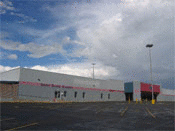The face of the American landscape has been forever changed by the invention of the "big box." These giant, typically nondescript retail meccas exemplified by Wal-Mart not only lead to the mowing-over of existing terrain, they also shift the cultural ecology of a space and bring with them more roads, more cars, and more garbage. But what happens when companies abandon these spaces in favor of paired-down, web-based operations? This is the question that artist Julia Christensen asks in her project Big Box Reuse. She's spent the last five years touring these renounced superstores, photographing them, collecting local residents' stories about the community impacts of the big boxes, and writing a forthcoming book. Documentation of these efforts are being exhibited through November 23rd at Carnegie Mellon University's Miller Gallery in an show curated by Astria Suparak, entitled "Your Town, Inc." Meanwhile, Turbulence has commissioned a forthcoming wiki on which the artist will invite people from across the country to upload their own stories, photos, and videos. Among the project's most poignant ironies is the question of what happens when the retailers that trade in over-packaged, often not-recyclable goods fail to successfully repurpose the structures in which they once perpetuated disposable culture. - Marisa Olson
Image: Julia Christensen, the Snowy Range Academy (Renovated Wal-Mart located in Laramie, WY) from Big Box Reuse, 2006